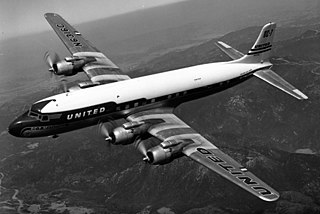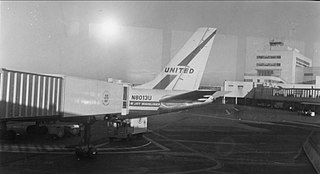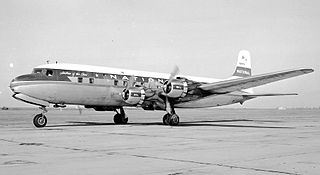Eastern Air Lines, also colloquially known as Eastern, was a major United States airline from 1926 to 1991. Before its dissolution, it was headquartered at Miami International Airport in an unincorporated area of Miami-Dade County, Florida.

Newark Liberty International Airport, originally Newark Metropolitan Airport and later Newark International Airport, is an international airport straddling the boundary between the cities of Newark in Essex County and Elizabeth in Union County, New Jersey. Located about 4.5 miles (7.2 km) south of downtown Newark, it is a major gateway to points in Europe, South America, Asia, and Oceania. It is jointly owned by the cities and leased to its operator, the Port Authority of New York and New Jersey. It is the second-busiest airport in the New York airport system, behind John F. Kennedy International Airport.

The Douglas DC-7 is an American transport aircraft built by the Douglas Aircraft Company from 1953 to 1958. A derivative of the DC-6, it was the last major piston engine-powered transport made by Douglas, being developed shortly after the earliest jet airliner—the de Havilland Comet—entered service and only a few years before the jet-powered Douglas DC-8 first flew in 1958. Unlike other aircraft in Douglas's line of propeller-driven aircraft, no examples remain in service in the present day, as compared to the far more successful DC-3 and DC-6.
Capitol Air was a charter airline and scheduled passenger air carrier based in the United States which was operational from 1946 to its bankruptcy filing on November 23, 1984. It was founded as Capitol Airways in 1946, and then renamed Capitol International Airways in 1967. In 1981, the airline changed its name to Capitol Air and was operating scheduled domestic and international passenger flights that year.

Capital Airlines was an airline serving the eastern, southern, southeastern, and midwestern United States. Capital's headquarters were located at Washington National Airport across the Potomac river from Washington, D.C. where crew training and aircraft overhauls were also accomplished. In the 1950s Capital was the fifth largest United States domestic carrier by passenger count after the Big Four air carriers.

On December 16, 1960, a United Airlines Douglas DC-8 bound for Idlewild Airport in New York City collided in midair with a TWA Lockheed L-1049 Super Constellation descending toward LaGuardia Airport. The Constellation crashed on Miller Field in Staten Island and the DC-8 in Park Slope, Brooklyn, killing all 128 aboard the two aircraft and six people on the ground. The accident, the world's deadliest aviation disaster at the time, remains the deadliest accident in the history of United Airlines as of 2022.

National Airlines Flight 2511 was a United States domestic passenger flight from New York City to Miami, Florida. On January 6, 1960, the Douglas DC-6 serving the flight exploded in midair. The National Airlines aircraft was carrying 5 crew members and 29 passengers, all of whom perished. The Civil Aeronautics Board investigation concluded that the plane was brought down by a bomb made of dynamite. No criminal charges were ever filed, nor was the blame for the bombing ever determined, though a suicide bombing is suspected. The investigation remains open.

Northeast Airlines Flight 823 was a scheduled flight from New York City's LaGuardia Airport to Miami International Airport, Florida, which crashed shortly after takeoff on February 1, 1957. The aircraft operating the service was a Douglas DC-6 four-engined propeller airliner, registration N34954, which entered service in 1955.

American Airlines Flight 157, a Douglas DC-6, departed on November 29, 1949, from New York City bound for Mexico City with 46 passengers and crew. After one engine failed in mid-flight, a series of critical mistakes by the flight crew caused the pilot to lose control of the plane during the final approach to a routine stopover at Love Field in Dallas, Texas. The airliner slid off the runway and struck a parked airplane, a hangar, and a flight school before crashing into a business across from the airport. 26 passengers and two flight attendants died. The pilot, co-pilot, flight engineer, and 15 passengers survived.

Daytona Beach International Airport is a county-owned airport located three miles (5 km) southwest of Daytona Beach, next to Daytona International Speedway, in Volusia County, Florida, United States. The airport has 3 runways, a six-gate domestic terminal, and an international terminal. Daytona Beach is the headquarters of Embry-Riddle Aeronautical University.

American Airlines Flight 6780, the first fatal crash of a Convair 240, occurred on January 22, 1952.

American Airlines Flight 63 was an American Airlines DC-3 nicknamed the Flagship Missouri that crashed on October 15, 1943, near Centerville, Tennessee, after ice formed on its wings and propeller. All eight passengers and three crewmembers died. This was the second fatal crash of an aircraft designated Flight 63, occurring 2+1⁄2 months after the crash of the Flagship Missouri’s sister ship, the Flagship Ohio.

American Airlines Flight 910, a four-engine Douglas DC-6 propliner, collided in mid-air with a single engine Temco Swift on final approach to Dallas Love Field on June 28, 1952, over Dallas, Texas. The DC-6 was carrying 55 passengers and 5 crew members from San Francisco, California. The DC-6 landed with no injuries to any of its 60 occupants, while both occupants of the two-person Swift died when their aircraft impacted the ground.

On April 4, 1955, a United Airlines Douglas DC-6 named Mainliner Idaho crashed shortly after taking off from Long Island MacArthur Airport, in Ronkonkoma, Islip, New York, United States.

On 7 June 1949, a Strato-Freight Curtiss Wright C-46D, registered in the United States as NC92857, crashed into the Atlantic Ocean 10 km (6.4 mi) west of San Juan-Isla Grande Airport in San Juan, Puerto Rico while en route to Miami, Florida. Of the 81 passengers and crew on board, 53 were killed.

On December 16, 1951, a Miami Airlines Curtiss C-46 Commando airliner crashed in the city of Elizabeth, New Jersey, shortly after taking off from nearby Newark Airport. All 56 people on board were killed. At the time, it was the second-deadliest aviation accident on US soil, behind Northwest Orient Airlines Flight 2501.

American Airlines Flight 1, dubbed "the New Yorker", was a regularly scheduled passenger flight. On October 30, 1941, when the route was a multiple stop flight from La Guardia Airport to Chicago Municipal Airport with intermediate stops at Newark, New Jersey; Buffalo, New York; Detroit, Michigan; and South Bend, Indiana, on the flight's leg between Buffalo and Detroit, the American Airlines Douglas DC-3-277B operating the route, on the flight's leg between Buffalo and Detroit, crashed into a wheat field approximately one half mile east of the town of Lawrence Station, Ontario, southwest of London. All aboard, including 17 passengers and 3 crew, were killed. It was the second of three fatal crashes during an operation of American Airlines Flight 1.














